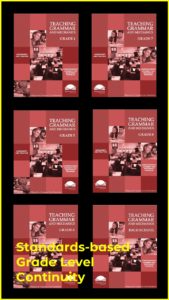Why Grammar Doesn’t Stick
 Last Wednesday, one of my favorite eighth grade English-language Arts colleagues burst into my fifth period seventh grade class. Herding ten of my previous students through the door to stand in front of my class, my clearly frustrated friend said, “My students can’t identify is as a linking verb in this practice sentence. I asked which students had you last year, and here they are.”
Last Wednesday, one of my favorite eighth grade English-language Arts colleagues burst into my fifth period seventh grade class. Herding ten of my previous students through the door to stand in front of my class, my clearly frustrated friend said, “My students can’t identify is as a linking verb in this practice sentence. I asked which students had you last year, and here they are.”
Now, you’ve got to understand my colleague. She did not interrupt my class to challenge my inadequate instruction in grammar and usage. She did not force students into a setting of public humiliation as a matter of punishment. She was not asking the question: Of what use is grammar and usage instruction?
She was simply asking the question: Why can’t students retain knowledge and application of simple grammar and usage from grade to grade? By the way… she knows that I taught is as a linking verb to those students.
You see, my colleague is not convinced by the research that purportedly indicates that direct grammar instruction has no impact on student acquisition of language skills. She recognizes the value of teaching language and wants her students to learn how to speak and write well. I share her views and her commitment to changing how she teaches to accommodate how her students learn. So do most English-language Arts teachers. So do the writers of the Language Strand of the Common Core State Standards.
So, what’s the answer to her question?
Why Doesn’t Grammar Stick?
No pat answers here; however, a few points should be considered. I’ll let the writers of the Common Core State Standards make these points regarding the recursive nature of instruction in grammar and usage:
“Grammar and usage development in children and in adults rarely follows a linear path.”
“Native speakers and language learners often begin making new errors and seem to lose their mastery of particular grammatical structures or print conventions as they learn new, more complex grammatical structures or new usages of English.”
(Bardovi-Harlig, 2000; Bartholomae, 1980; DeVilliers & DeVilliers, 1973; Shaughnessy, 1979).
“These errors are often signs of language development as learners synthesize new grammatical and usage knowledge with their current knowledge. Thus, students will often need to return to the same grammar topic in greater complexity as they move through K–12 schooling and as they increase the range and complexity of the texts and communicative contexts in which they read and write.”
“The Standards account for the recursive, ongoing nature of grammatical knowledge in two ways. First, the Standards return to certain important language topics in higher grades at greater levels of sophistication… Second, the Standards identify with an asterisk (*) certain skills and understandings that students are to be introduced to in basic ways at lower grades but that are likely in need of being retaught and relearned in subsequent grades as students’ writing and speaking matures and grows more complex.”
http://www.corestandards.org/assets/Appendix_A.pdf
*****

Pennington Publishing Grammar Programs
Teaching Grammar, Usage, and Mechanics (Grades 4, 5, 6, 7, 8, and High School) are full-year, traditional, grade-level grammar, usage, and mechanics programs with plenty of remedial practice to help students catch up while they keep up with grade-level standards. Twice-per-week, 30-minute, no prep lessons in print or interactive Google slides with a fun secret agent theme. Simple sentence diagrams, mentor texts, video lessons, sentence dictations. Plenty of practice in the writing context. Includes biweekly tests and a final exam.
Grammar, Usage, and Mechanics Interactive Notebook (Grades 4‒8) is a full-year, no prep interactive notebook without all the mess. Twice-per-week, 30-minute, no prep grammar, usage, and mechanics lessons, formatted in Cornell Notes with cartoon response, writing application, 3D graphic organizers (easy cut and paste foldables), and great resource links. No need to create a teacher INB for student make-up work—it’s done for you! Plus, get remedial worksheets, biweekly tests, and a final exam.
Syntax in Reading and Writing is a function-based, sentence-level syntax program, designed to build reading comprehension and increase writing sophistication. The 18 parts of speech, phrases, and clauses lessons are each leveled from basic (elementary) to advanced (middle and high school) and feature 5 lesson components (10–15 minutes each): 1. Learn It! 2. Identify It! 3. Explain It! (analysis of challenging sentences) 4. Revise It! (kernel sentences, sentence expansion, syntactic manipulation) 5. Create It! (Short writing application with the syntactic focus in different genre).
Get the Diagnostic Grammar, Usage, and Mechanics Assessments, Matrix, and Final Exam FREE Resource:
![]()